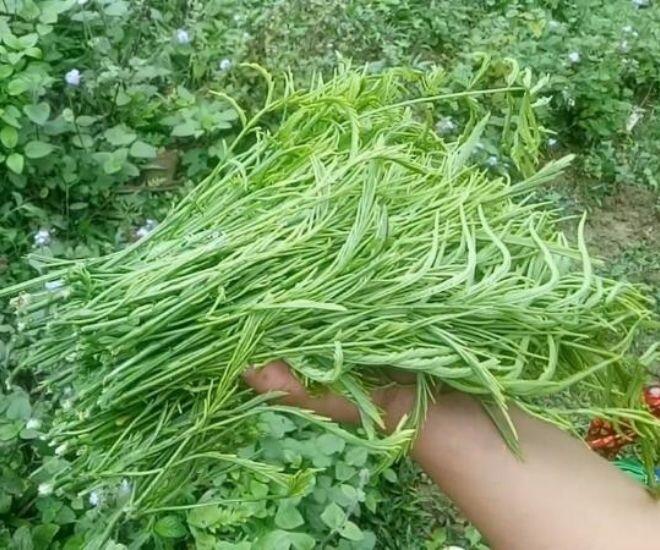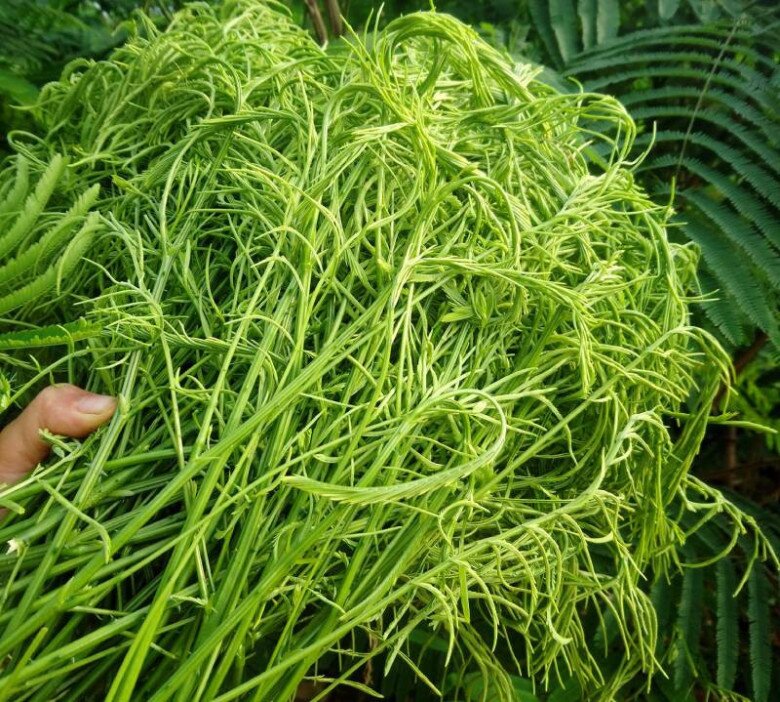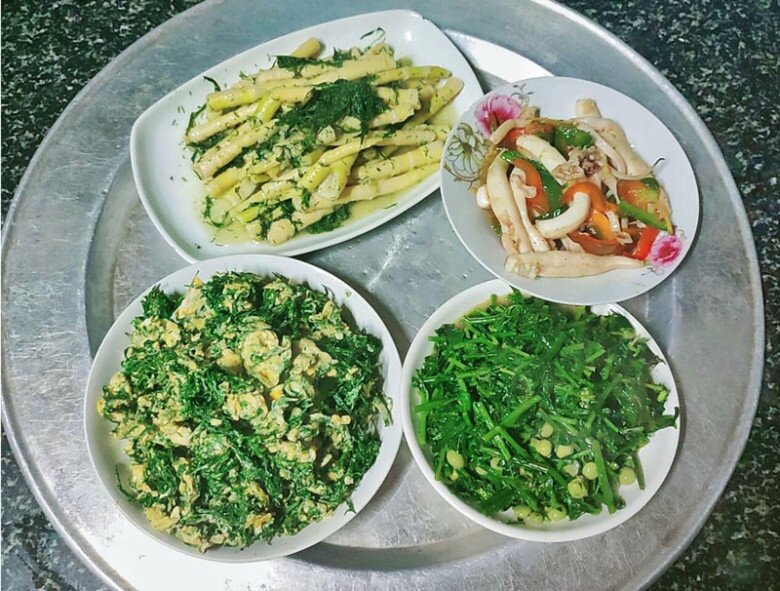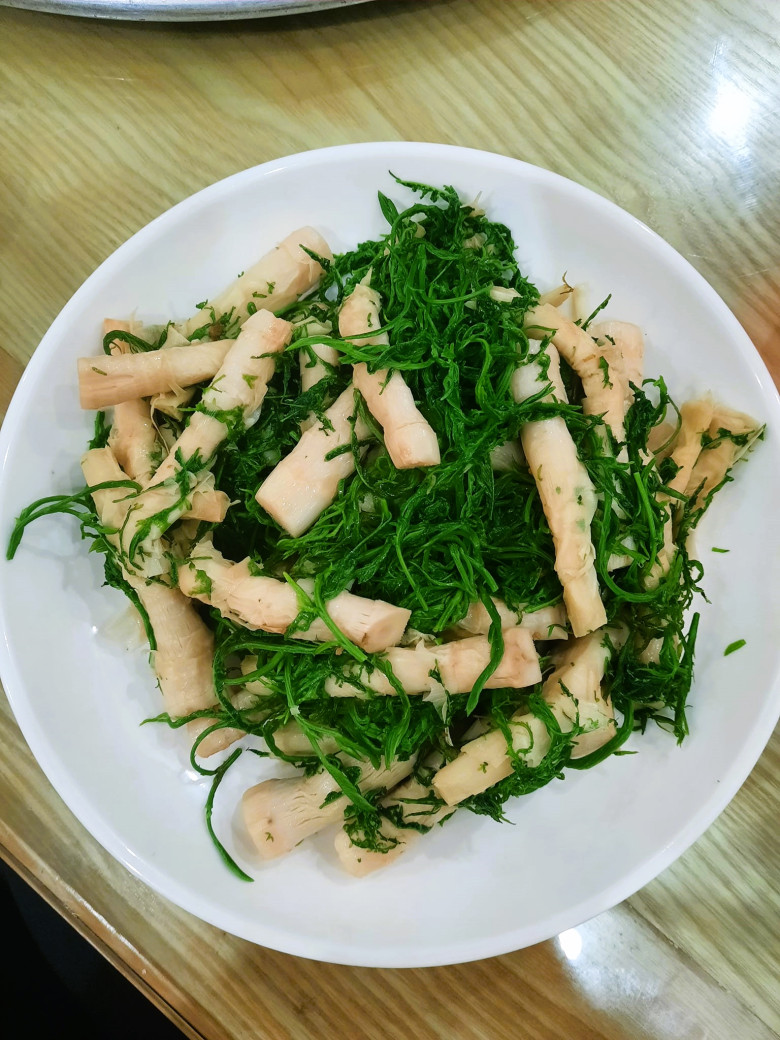
In the Thai ethnic language, “pắc nam” refers to a wild vine known as stinkweed. This plant thrives in the forests, characterized by its long, thorny stems and dark green, symmetrical leaves. The tender young shoots are highly prized, often used in cooking or as herbal medicine. Harvesting requires caution due to the sharp thorns that can easily scratch the skin.
Stinkweed flourishes between March and June, coinciding with the lush greenery and humid climate of the Northwest region. It is most abundant in provinces like Son La, Dien Bien, Lai Chau, and Yen Bai. During this season, local highland markets often feature freshly harvested stinkweed. Beyond local consumption, it is transported to major cities like Hanoi, where it graces the menus of Northwest specialty restaurants. In Hanoi, prices can soar to several hundred thousand dong per kilogram, whereas purchasing directly from local villagers costs only a fraction of that.
The Aroma of Mountainous Forest Greens
The name “stinkweed” stems from its potent, distinctive odor, which can be off-putting to first-time encounters. However, some argue that the scent is merely unusual rather than genuinely foul. Interestingly, the smell mellows after harvesting and resting. Locals prefer consuming it fresh to fully appreciate its robust flavor.
When cooked, stinkweed transforms into a fragrant, crisp, and sweet delicacy. This contrast between its raw scent and cooked taste makes it uniquely appealing. Many visitors, initially hesitant, grow to love it, even purchasing it as a souvenir.

Beyond its culinary appeal, stinkweed is a valued herbal remedy. Northwest locals use it to cool down during summer and treat joint ailments. Dried stinkweed is also used in traditional medicine to address liver, kidney, and stomach issues, as well as acid reflux, abdominal pain, and bitter taste in the mouth. Its health benefits have made it a sought-after delicacy, prized for both flavor and wellness.
Delectable Dishes Featuring Stinkweed
Northwest cuisine is renowned for its creative fusion of forest produce and ethnic culinary techniques. Stinkweed is no exception, inspiring a variety of unique and nutritious dishes.
Stinkweed Salad with Bitter Melon and Dried Pork: A highlight in highland restaurant menus, this dish combines blanched stinkweed with bitter melon and shredded dried pork, seasoned with fish sauce, lime, chili, and peanuts. The result is a refreshing, tangy, and savory salad.
Pork Tail Soup with Stinkweed: A nourishing family favorite, this soup features tender pork tail simmered with stinkweed. The sweet broth and tender meat complement the unique flavor of stinkweed, creating a wholesome dish.
Stinkweed Stir-fried with Bamboo Shoots: A simple yet authentic highland dish, combining crisp bamboo shoots with stinkweed for a light, refreshing flavor—perfect for summer meals.
Grilled Stuffed Fish with Stinkweed: A festival specialty, freshwater fish like carp or grass carp are cleaned, stuffed with stinkweed and spices, then grilled over charcoal. The aromatic blend of fish and stinkweed leaves a lasting impression.
Stinkweed Patties: A creative dish where minced stinkweed is mixed with ground meat, seasoned, and pan-fried until crispy. Served with rich fish sauce, these patties are a hit among young food enthusiasts exploring Northwest cuisine.
Stinkweed Egg Drop Soup: Similar to tomato egg drop soup but with stinkweed, this dish offers a bolder flavor, ideal for those accustomed to its taste and seeking a unique culinary experience.
Stinkweed can also be simply boiled and dipped in fish sauce or stir-fried with beef or pork. Each preparation method offers a distinct sensory experience, cementing stinkweed’s role as both a staple and a cultural culinary symbol.

For travelers, selecting a region-specific souvenir is essential, and stinkweed is an intriguing choice. Though less common than tea or plums, it offers a rare and practical option. Many visitors opt for fresh or dried stinkweed as gifts, despite its higher urban prices, valuing its unique flavor and health benefits.
Today, stinkweed has transcended highland home cooking, appearing on city restaurant menus and tourist offerings. It stands as one of the Northwest’s most distinctive specialties, intriguing with its name and flavor profile.

Beyond its initial aromatic impression, stinkweed reveals a delightful crispness and sweetness when cooked, showcasing the sophistication of local culinary culture. With its culinary and medicinal value, stinkweed is a source of pride for the Northwest mountains, offering a unique gift for those eager to explore Vietnam’s regional specialties.

































